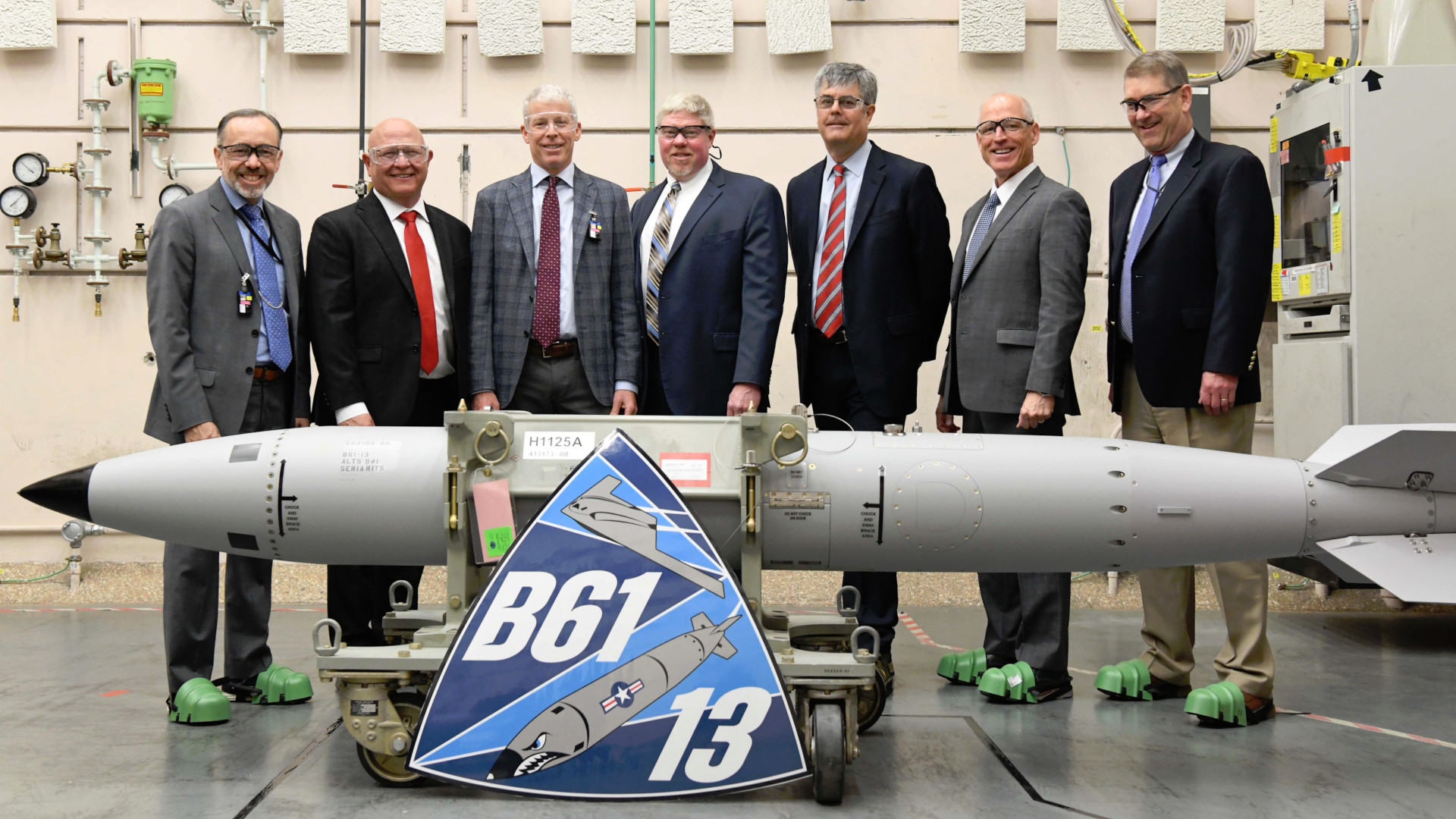Skip to comments.
Far More Powerful B61-13 Guided Nuclear Bomb Variant Joins U.S. Stockpile
The War Zone ^
| May 19 2025
| Joseph Trevithick
Posted on 05/19/2025 1:14:56 PM PDT by texas booster
U.S. officials say adding the B61-13 bomb to America's nuclear arsenal is key to holding certain underground and large area targets at risk.
he first production example of the new B61-13 nuclear bomb has been completed roughly a year ahead of schedule, according to the U.S. Department of Energy. The B61-13 is based on the preceding B61-12, but offers a higher maximum yield that U.S. officials say offers important additional capacity to hold hardened targets, such as underground command and control facilities, and ones spread across physically larger areas, at risk.
The U.S. military first announced plans to develop and field the B61-13, primarily as a replacement for the B61-7 variant, in 2023. The plan had previously been for the B61-12 to supplant the B61-7, as well as the B61-3 and B61-4 versions. The B61 is America’s longest-serving family of nuclear gravity bombs, and you can read more about the existing members thereof here.
TOPICS: Extended News; Government; News/Current Events; US: Texas
KEYWORDS: b6113; nucleararsenal; nuclearbomb; nukes
Navigation: use the links below to view more comments.
first 1-20, 21-40, 41-51 next last
“[The] Pantex Plant has completed the first production unit of the B61-13 nuclear gravity bomb – designed to strengthen the flexibility and credibility of America’s nuclear deterrent,” according to a social media post today from the Department of Energy, which also included a small glimpse of the weapon. “This major milestone for America’s nuclear stockpile was completed a year ahead of schedule!”
“Modernizing America’s nuclear stockpile is essential to delivering President Trump’s peace through strength agenda,” Secretary of Energy Chris Wright said in a statement today. “The remarkable speed of the B61-13’s production is a testament to the ingenuity of our scientists and engineers and the urgency we face to fortify deterrence in a volatile new age. It was my honor today to stamp the first completed unit at the Pantex Plant in Amarillo, Texas, where all the efforts of NNSA’s labs, plants, and sites culminated in this amazing milestone. This achievement signals American strength to our adversaries and allies alike.”
The Pantex Plant in Texas is where U.S. nuclear weapons are assembled and disassembled, and the facility also oversees testing and evaluation activities. Pantex falls under the oversight of the Department of Energy’s National Nuclear Security Administration (NNSA), which manages the development of new and improved nuclear weapons and sustains America’s existing nuclear stockpile.
“NNSA anticipated achieving the first production unit for the B61 Mod 13 later this month, almost a full year ahead of schedule,” Teresa Robbins, NNSA’s Acting Administrator, had told members of the House Armed Services Committee on May 7. Robbins’ prepared remarks for the hearing said that “taking advantage of existing B61 production lines” had been a key factor in accelerating work on the new version.
“Decades of B61 design and qualification data gave NNSA’s program managers and engineers from the national laboratories and production plants confidence that they could accept calculated risks to speed production,” per an NNSA press release today. “By streamlining or in some cases combining ‘design gates’ – the rigorous reviews conducted at each step of a weapon design process – engineers were able to commence production far sooner than a standard schedule would allow. These efficiencies allowed B61-13 hardware ‘test builds’ to be manufactured just three months after the program received authorization and appropriation from Congress.”
From the pictures that have been released to date, it looks essentially identical to the B61-12 externally. The B61-13 notably features the same tail kit assembly (TKA) containing an inertial navigation system (INS) guidance package that was introduced on the B61-12.
To: 38special; 9422WMR; a fool in paradise; AirForce-TechSgt; al_c; Alamo-Girl; Allegra; ...
Texas Ping, the Best State in the USA!
A ping out to the Texas Ping list, founded by Windflier.
More good news out of Pantex!
Another special Texas summer edition for your perusal.
As always, please FReepmail me if you want on or off the Texas Ping list.
Blessings, and stay cool!
In addition, “the B61-13 incorporates the same modern safety, security, and accuracy features as the B61-12,” according to today’s NNSA release.
Yield is where the B61-13 is understood to differ most from the B61-12. All B61 variants are so-called “dial-a-yield” weapons that can be set to detonate with varying degrees of explosive force. Though the exact figures are classified, the U.S. government has said the maximum yield of the B61-13 will be in line with the previous B61-7 version it is intended to replace, the highest yield setting on which is reportedly between 340 and 360 kilotons. The reported maximum yield of the B61-12 is 50 kilotons.
The B61-7 is one of the most powerful nuclear gravity bombs in the U.S. stockpile now. Despite the lower maximum yield, the U.S. military had previously argued that the new guidance capability found on the B61-12, which is also spin-stabilized using small rocket motors positioned around the rear of its body for additional accuracy, would allow it to hold hardened targets, even ones deep underground, at risk by being able to focus explosive force on a more precise point. Even before the announcement of plans for the B61-13 two years ago, the U.S. government had already been steadily walking back expectations for the B61-12.
2
posted on
05/19/2025 1:17:32 PM PDT
by
texas booster
(Join FreeRepublic's Folding@Home team (Team # 36120) Cure Alzheimer's!)
To: texas booster
That’s nice. Now use it on Mecca.
3
posted on
05/19/2025 1:18:04 PM PDT
by
BenLurkin
(The above is not a statement of fact. It is opinion or satire. Or both.)
To: texas booster
A very interesting graphic accompanying the article.

4
posted on
05/19/2025 1:18:52 PM PDT
by
texas booster
(Join FreeRepublic's Folding@Home team (Team # 36120) Cure Alzheimer's!)
To: texas booster
What does this mean? “to hold hardened targets”
Is “hold” a modern euphemism for “destroy”?
In military parlance, “hold” means don’t let the enemy overrun your position. But that doesn’t fit here.
5
posted on
05/19/2025 1:22:53 PM PDT
by
ProtectOurFreedom
(“Diversity is our Strength” just doesn’t carry the same message as “Death from Above”)
To: texas booster
“The B61-13 announced on Friday, on the other hand, will be comparable in yield to the soon-to-be-defunct B61-7, at approximately 360 kilotons.”
“ …21 times the yield of the atomic bomb dropped on Hiroshima in 1945…”
.
For those interested in such things…
To: texas booster
How do I get me a pair of them steel-toed Crocs?

7
posted on
05/19/2025 1:26:02 PM PDT
by
billorites
(freepo ergo sum)
To: ProtectOurFreedom
“What does this mean? “to hold hardened targets””
It means to hold hardened targets at risk; at risk of being destroyed.
To: ProtectOurFreedom
It’s a strangely constructed sentence; it’s really “hold at risk hardened targets”, but the “at risk” is far away from “to hold”.
9
posted on
05/19/2025 1:27:23 PM PDT
by
Campion
(Everything is a grace, everything is the direct effect of our Father's love - Little Flower)
To: GaltAdonis
“The B61-13 announced on Friday, on the other hand, will be comparable in yield to the soon-to-be-defunct B61-7
What do they do with the 'defunct' bombs? Do they go on sale on eBay? ;)
10
posted on
05/19/2025 1:34:19 PM PDT
by
adorno
( )
To: texas booster
When will it be available on Amazon? That’s the really important question.
To: adorno
The nuclear payload is “recycled”, as are any reusable parts. Rest is destroyed, for obvious reasons.
To: texas booster
Loaded the first B-61’s, MK-61 back then, on F-100’s in the late 60’s.
13
posted on
05/19/2025 1:49:56 PM PDT
by
Wilum
(Never loaded a nuke I didn't )
To: texas booster
From the article:
“the U.S. government has said the maximum yield of the B61-13 will be in line with the previous B61-7 version it is intended to replace, the highest yield setting on which is reportedly between 340 and 360 kilotons. The reported maximum yield of the B61-12 is 50 kilotons.”
The
14
posted on
05/19/2025 1:54:22 PM PDT
by
BeauBo
To: BeauBo
Is this now a two stage bomb? Can it be put it on cruise missiles, doubtful.
15
posted on
05/19/2025 2:21:59 PM PDT
by
Mouton
(There is a new sheriff and deputy in town to now!)
To: ProtectOurFreedom
The phrase in question is “hold at risk”, not simply “hold”.
If the meaning is not now obvious to you, I’ll try to help.
16
posted on
05/19/2025 2:25:31 PM PDT
by
NorthMountain
(... the right of the people to keep and bear arms shall not be infringed)
To: ProtectOurFreedom
“offers important additional capacity to hold hardened targets, such as underground command and control facilities, and ones spread across physically larger areas, at risk.”
Read it again. It’s a complex sentence. “offers important additional capacity to “HOLD HARDENED TARGETS, such as underground command and control facilities, and ones spread across physically larger areas, AT RISK.”
To hold them at risk of attack.
17
posted on
05/19/2025 2:26:53 PM PDT
by
DesertRhino
(2016 Star Wars, 2020 The Empire Strikes Back, 2025... RETURN OF THE JEDI...Low IQ morons also have t)
To: Spacetrucker
>> The nuclear payload is “recycled”, as are any reusable parts. Rest is destroyed, for obvious reasons.
Dropping it on (say) Minneapolis would kill two birds with one stone:
*** Testing the device end-to-end
*** Destroying the design details, for obvious reasons
Actually kill THREE birds, counting destroying a progressive hellhole like Minneapolis...
18
posted on
05/19/2025 2:28:26 PM PDT
by
Nervous Tick
(Hope, as a righteous product of properly aligned Faith, IS in fact a strategy.)
To: Spacetrucker
The nuclear payload is “recycled”, as are any reusable parts. Rest is destroyed, for obvious reasons.
Aw, shucks! I had my bank account ready to buy.
19
posted on
05/19/2025 2:29:24 PM PDT
by
adorno
( )
To: billorites
20
posted on
05/19/2025 2:45:08 PM PDT
by
ansel12
((NATO warrior under Reagan, and RA under Nixon, bemoaning the pro-Russians from Vietnam to Ukraine.))
Navigation: use the links below to view more comments.
first 1-20, 21-40, 41-51 next last
Disclaimer:
Opinions posted on Free Republic are those of the individual
posters and do not necessarily represent the opinion of Free Republic or its
management. All materials posted herein are protected by copyright law and the
exemption for fair use of copyrighted works.
FreeRepublic.com is powered by software copyright 2000-2008 John Robinson


